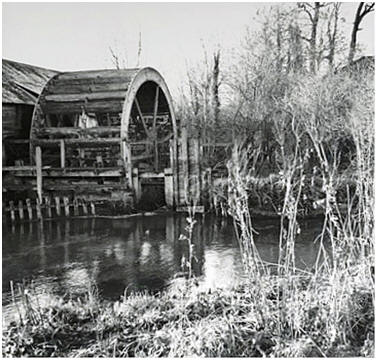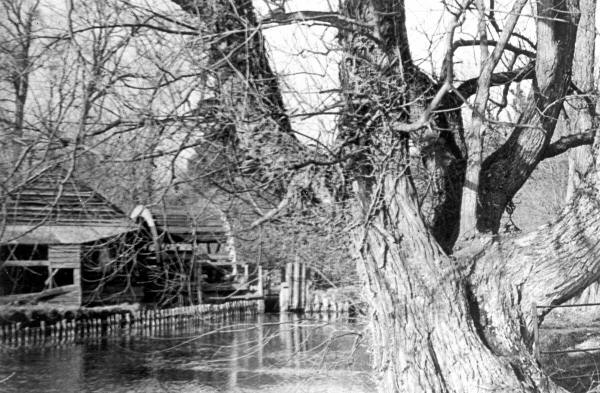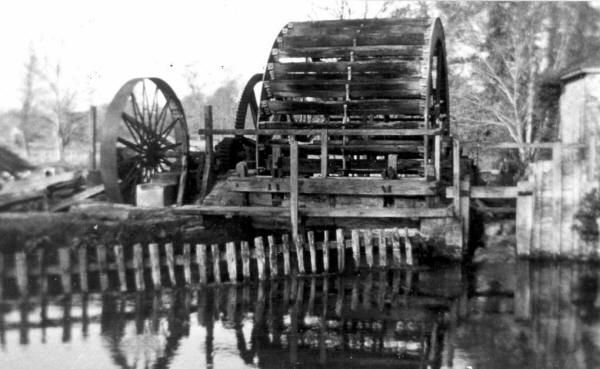|
  |
|
Page 2 |
Newsletter 134 Autumn 2021 © Hampshire Mills Group |
Kings Worthy Sawmill
Derek Brockway
|
|
 |
This mystery photo
has been identified as being Kings Worthy Mill and
it is part of the archive of the Worthys Local
History Group.
Hampshire Mills Group
in The Mills and Millers of Hampshire has two
references to Kings Worthy Mills. Most people think
the mill at the bottom of Mill Lane in Abbots Worthy
is Kings Worthy Mill but it’s actually Abbots Worthy
Mill and the other mill mentioned is at Lovington
further up the Itchen valley.
Editor: So
our book does not include this mill site.
|
|
Immediately east of St Mary’s Church in Kings Worthy
is a short track and gateway which once gave access
to Kings Worthy Mill yard and thence to the mill
itself.
We
know from Domesday the village had a mill, in fact
several, but it wasn’t till a map of 1701 showing
the Itchen from Abbots Worthy to Durngate that we
get an idea of its position, and then we have to
wait another 50 years before the Godson map reveals
its precise location.
The
mill would have originally ground corn for the local
farmers but from the mid-19th century the import of
cheaper and different grain from North America and
Russia that used roller mills led to a decline in
work for local mills and a need to use the water
power and equipment for other purposes. In 1862 we
know from the bankruptcy of its owner that it had
become a water-powered sawmill and that’s how it
continued for the next 60 years or so under a number
of different owners. The writing was on the wall for
the sort of operation that simply reduced tree
trunks to planks as vast quantities of ready-sawn
timber were imported from the Baltic and North
America. It seems added value came from making the
wood into toys, manufacturing brooms, cricket bats,
and lathe-turned goods.
By
the 1890s the mill owner also had an interest in a
mill at the Butts in Alton, where there is no water
so we can assume that he recognised the efficiency,
if not the sustainability, of steam.
|
|
After his death, there followed a period of slow
decline and dereliction pictured in a few enigmatic
photos. They show unromantic images of
insubstantial timber framed buildings clad in
corrugated iron that were all demolished during the
construction of the Winchester bypass in the late
1930s when a stretch of the river was realigned.
Whilst these photos show an undershot wheel and a
shaft into one of the sheds we have to rely on part
of an estate agents description of the equipment in
a 1909 letter to a client:
The
premises comprise drying sheds, stabling, offices,
store sheds etc. The machinery consists of a 20hp
water wheel, a 3ft 6ins horizontal saw, 4 large and
small circular saws, veneer machine, lathes etc.
Anyone interested in finding out more is welcome to
contact me via the Worthy Local History Group
website
or the newsletter editor.
|

Worthys Local History Group |
|
HMG
member Ivor New had already commented:
I
have seen the picture you published but the only
other version I can find is in a history group email
I received years ago. The mill and local water
courses are now under the bypass with the river
being diverted alongside. I think the only remaining
evidence of the mill is a road sign Mill Lane near
the church.
The
bypass was more or less finished in 1938 but not
opened to traffic until the end of World War 2 – my
father described how the carriageways had been
covered with camouflaged storage units, protected
by the Spitfire Bridge – which, while small aircraft
have flown under it Spitfires have not. The name is
supposed to have come from the fact that many of the
storage units stored Spitfire components and
subassemblies for the early manufacture of
Spitfires, certainly before the main production
moved to the Midlands.
|
|
Editor:
Ivor had initially sent me a copy of Derek’s talk
to the Worthys Local History Group, in which he
mentions that the Ings family were probably the most
well-known owners of the business. I think that the
mill was known locally as Ings Mill because in 2007,
I photographed a picture which was labelled Ings
Mill which was identical to the picture below that
was supplied by Derek. It was on display in the
King Charles pub at Springvale.
I wondered why – was it
just typical pub decoration? I had assumed that 'Ings'
was the place where the mill was located, not the
owner's name. I even went to Ings in Cumbria to
look for it!

Worthys Local History Group
|
  |
|
|
